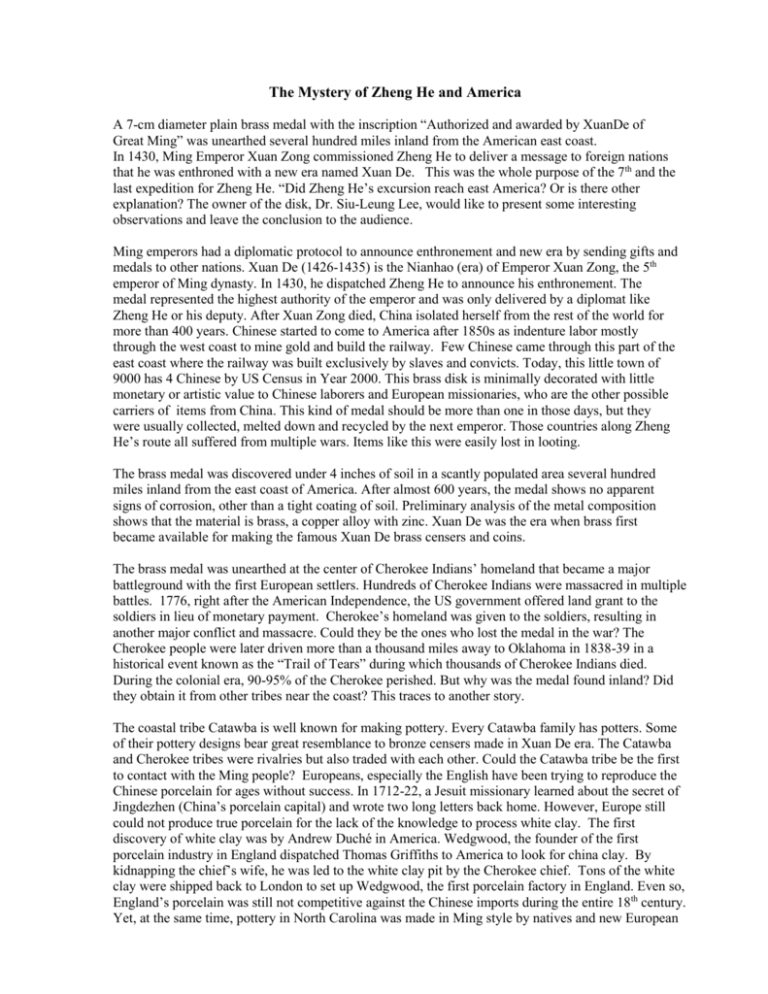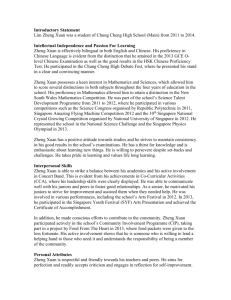here - Gavin Menzies
advertisement

The Mystery of Zheng He and America A 7-cm diameter plain brass medal with the inscription “Authorized and awarded by XuanDe of Great Ming” was unearthed several hundred miles inland from the American east coast. In 1430, Ming Emperor Xuan Zong commissioned Zheng He to deliver a message to foreign nations that he was enthroned with a new era named Xuan De. This was the whole purpose of the 7th and the last expedition for Zheng He. “Did Zheng He’s excursion reach east America? Or is there other explanation? The owner of the disk, Dr. Siu-Leung Lee, would like to present some interesting observations and leave the conclusion to the audience. Ming emperors had a diplomatic protocol to announce enthronement and new era by sending gifts and medals to other nations. Xuan De (1426-1435) is the Nianhao (era) of Emperor Xuan Zong, the 5th emperor of Ming dynasty. In 1430, he dispatched Zheng He to announce his enthronement. The medal represented the highest authority of the emperor and was only delivered by a diplomat like Zheng He or his deputy. After Xuan Zong died, China isolated herself from the rest of the world for more than 400 years. Chinese started to come to America after 1850s as indenture labor mostly through the west coast to mine gold and build the railway. Few Chinese came through this part of the east coast where the railway was built exclusively by slaves and convicts. Today, this little town of 9000 has 4 Chinese by US Census in Year 2000. This brass disk is minimally decorated with little monetary or artistic value to Chinese laborers and European missionaries, who are the other possible carriers of items from China. This kind of medal should be more than one in those days, but they were usually collected, melted down and recycled by the next emperor. Those countries along Zheng He’s route all suffered from multiple wars. Items like this were easily lost in looting. The brass medal was discovered under 4 inches of soil in a scantly populated area several hundred miles inland from the east coast of America. After almost 600 years, the medal shows no apparent signs of corrosion, other than a tight coating of soil. Preliminary analysis of the metal composition shows that the material is brass, a copper alloy with zinc. Xuan De was the era when brass first became available for making the famous Xuan De brass censers and coins. The brass medal was unearthed at the center of Cherokee Indians’ homeland that became a major battleground with the first European settlers. Hundreds of Cherokee Indians were massacred in multiple battles. 1776, right after the American Independence, the US government offered land grant to the soldiers in lieu of monetary payment. Cherokee’s homeland was given to the soldiers, resulting in another major conflict and massacre. Could they be the ones who lost the medal in the war? The Cherokee people were later driven more than a thousand miles away to Oklahoma in 1838-39 in a historical event known as the “Trail of Tears” during which thousands of Cherokee Indians died. During the colonial era, 90-95% of the Cherokee perished. But why was the medal found inland? Did they obtain it from other tribes near the coast? This traces to another story. The coastal tribe Catawba is well known for making pottery. Every Catawba family has potters. Some of their pottery designs bear great resemblance to bronze censers made in Xuan De era. The Catawba and Cherokee tribes were rivalries but also traded with each other. Could the Catawba tribe be the first to contact with the Ming people? Europeans, especially the English have been trying to reproduce the Chinese porcelain for ages without success. In 1712-22, a Jesuit missionary learned about the secret of Jingdezhen (China’s porcelain capital) and wrote two long letters back home. However, Europe still could not produce true porcelain for the lack of the knowledge to process white clay. The first discovery of white clay was by Andrew Duché in America. Wedgwood, the founder of the first porcelain industry in England dispatched Thomas Griffiths to America to look for china clay. By kidnapping the chief’s wife, he was led to the white clay pit by the Cherokee chief. Tons of the white clay were shipped back to London to set up Wedgwood, the first porcelain factory in England. Even so, England’s porcelain was still not competitive against the Chinese imports during the entire 18th century. Yet, at the same time, pottery in North Carolina was made in Ming style by natives and new European immigrants. What took China close to 10,000 years to perfect was not so easily learned even by the technologically adept Europeans at that time. How could the Neolithic Cherokee and Catawba Indians master this technology so well? The most fascinating fact is the Cherokee term for china clay (kaolin) is “unaker”, similar to what Chinese call it “uk-nake”in southern dialect. Is it a coincidence? All this happened before the arrival of the Europeans. The name uk-nake was used up to Ming dynasty. It was replaced by other terms like china clay. A Jingdezhen porcelain expert said that Zheng He might have brought the clay bricks (petuntse or baidunzi) along with the porcelain gifts. The Cherokee people have two original flags, viz. one with a white background and the Bigger Dipper constellation in red that they called the peace flag. The war flag is reversed in color. Observation of constellation has been a routine in China since ChunQiu era. A flag with the Bigger Dipper has been used as one of several flags in imperial ceremonial parade from Song dynasty to Qing dynasty. The Ming emperors were especially fond of the Big Dipper in association with their Daoist belief. Zheng He used an instrument Qian Xing Ban (Boards aligning with the stars) to calculate the latitude using the Polaris and the bigger Dipper. On the other hand, lacking a written language to record the celestial observations, the Cherokee people had no knowledge of other constellations on record. According to the history of Ming dynasty, Zheng He died in India in 1433. But it has never been proven since his body could not be shipped back to China. Ming dynasty had significant advances in brass and porcelain. The brass medal is a specific case and pottery a general case. Could these clues change the history we have been told? More research is necessary. A chemist by profession, Dr. Lee has been interested in Chinese culture in many aspects. In 1996, Dr. Lee founded the Asiawind.com website which hosts the world’s first Chinese calligraphy website and a Chinese antique website that drew attention to an inquiry about the medal. To many, this medal might be easily discarded as a piece of scrap metal. Perhaps it is the combined knowledge of Chinese history, calligraphy and chemistry that allowed Dr. Lee to recognize the significance of this obscure brass plate. Ironically, Dr. Lee lives in Columbus, Ohio, USA. For further information, please contact: Siu-Leung Lee, PhD SLLEE@ASIAWIND.COM http://www.asiawind.com









